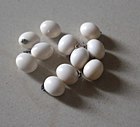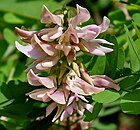Note: This is a project under development. The articles on this wiki are just being initiated and broadly incomplete. You can Help creating new pages.
Abrus precatorius - Gunja
Abrus precatorius is a severely invasive plant in warm temperate to tropical regions. The plant is best known for its seeds, which are used as beads and in percussion instruments and which are toxic because of the presence of abrin. This plant belongs to Fabaceae family.
Contents
- 1 Uses
- 2 Parts Used
- 3 Chemical Composition
- 4 Common names
- 5 Properties
- 6 Habit
- 7 Identification
- 8 Identification
- 9 List of Ayurvedic medicine in which the herb is used
- 10 Where to get the saplings
- 11 Mode of Propagation
- 12 How to plant/cultivate
- 13 Season to grow
- 14 Required Ecosystem/Climate
- 15 Kind of soil needed
- 16 Commonly seen growing in areas
- 17 Photo Gallery
- 18 References
- 19 External Links
Uses
Blisters in mouths, Mouth sores, Bleeding piles, Leucorrhoea, Mild diabetes, Cough, Physical weakness, Ulcer, Urinary trouble, Snakebite, Infection in intestine.[1]
Parts Used
Chemical Composition
Mature seeds contain alkali like abrine, precatorine, etc.[2]
Common names
| Language | Common name |
|---|---|
| Kannada | Gulaganji, ಗುಲಗಂಜಿ |
| Hindi | Gaungchi, Gunchi |
| Malayalam | Kunni, Kunnikkuru |
| Tamil | Gundumani, Kundumani |
| Telugu | Gurivinda |
| Marathi | NA |
| Gujarathi | NA |
| Punjabi | NA |
| Kashmiri | NA |
| Sanskrit | Gunja |
| English | Equirity |
Properties
Reference: Dravya - Substance, Rasa - Taste, Guna - Qualities, Veerya - Potency, Vipaka - Post-digesion effect, Karma - Pharmacological activity, Prabhava - Therepeutics.
Dravya
Rasa
Tikta (Bitter), Kashaya (Astringent)
Guna
Laghu (Light), Ruksha (Dry)
Veerya
Ushna (Hot)
Vipaka
Katu (Pungent)
Karma
Kapha, Vata
Prabhava
Habit
Identification
Leaf
| Kind | Shape | Feature |
|---|---|---|
| Paripinnate | Obovate | Leaves are alternately arranged, leaflets 12-16 pairs, 0.8-2.5 x 0.4-1 cm, oblong to elliptic, base and apex obtuse |
Flower
| Type | Size | Color and composition | Stamen | More information |
|---|---|---|---|---|
| Bisexual | 2-4cm long | Pink/white | 9 | Flowering July to March in short axillary racemes |
Fruit
| Type | Size | Mass | Appearance | Seeds | More information |
|---|---|---|---|---|---|
| Oblong pod | Thinly septate | Pilose, wrinkled | Subglobose | Seeds upto 5 | Fruiting throughout the year |
Other features
Identification
Leaf
| Kind | Shape | Feature |
|---|---|---|
| Simple | Linear in outline | Leaves occur along the entire length of each culm, becoming less abundant above |
Flower
| Type | Size | Color and composition | Stamen | More information |
|---|---|---|---|---|
| Simple | Ovoid | 4.5–5 mm. long | White when mature |
List of Ayurvedic medicine in which the herb is used
- Neelibhrungadi tailam as root juice extract
- Sarivadi Vati as root juice extract
Where to get the saplings
Mode of Propagation
How to plant/cultivate
Seeds naturally have a low germination rate. The hard and impenetrable seed coat is one of the reasons.[6]
Season to grow
Required Ecosystem/Climate
Kind of soil needed
Commonly seen growing in areas
Tropical area, Subtropical area.
Photo Gallery
References
- ↑ Karnataka Aushadhiya Sasyagalu By Dr.Maagadi R Gurudeva, Page no:121
- ↑ Chemistry
- ↑ 3.0 3.1 Morphology
- ↑ 4.0 4.1 Kappathagudda - A Repertoire of Medicinal Plants of Gadag book, Page no: 30
- ↑ Ayurvedic preparations
- ↑ Cultivation details
External Links
- Ayurvedic Herbs known to be helpful to treat Blisters in mouths
- Ayurvedic Herbs known to be helpful to treat Mouth sores
- Ayurvedic Herbs known to be helpful to treat Bleeding piles
- Ayurvedic Herbs known to be helpful to treat Leucorrhoea
- Ayurvedic Herbs known to be helpful to treat Mild diabetes
- Ayurvedic Herbs known to be helpful to treat Cough
- Ayurvedic Herbs known to be helpful to treat Physical weakness
- Ayurvedic Herbs known to be helpful to treat Ulcer
- Ayurvedic Herbs known to be helpful to treat Urinary trouble
- Ayurvedic Herbs known to be helpful to treat Snakebite
- Ayurvedic Herbs known to be helpful to treat Infection in intestine
- Herbs with Seeds used in medicine
- Herbs with Stem used in medicine
- Herbs with Leaves used in medicine
- Herbs with Roots used in medicine
- Herbs with common name in Kannada
- Herbs with common name in Hindi
- Herbs with common name in Malayalam
- Herbs with common name in Tamil
- Herbs with common name in Telugu
- Herbs with common name in Sanskrit
- Herbs with common name in English
- Habit - Deciduous climber
- Index of Plants which can be propagated by Seeds
- Index of Plants which can be propagated by Cuttings
- Herbs that are commonly seen in the region of Tropical area
- Herbs that are commonly seen in the region of Subtropical area
- Herbs
- Climber
- Fabaceae





